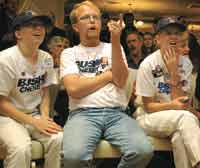IT'S BUSH... MAYBE
Experts say president may be named today
By ANTHONY WITRADO
The country heard it in 2000.
George W. Bush is president of the United States—most likely.
That was the feeling around the country as of 11 p.m. Tuesday. With incumbent
Preisdent Bush apparently leading the popular and electoral votes, the
race for the president of the United States was still too tight to decide.
But it didn’t look good for Sen. John Kerry. So much so that talk
show host Larry King said a Kerry comeback would be more impressive than
the Boston Red Sox’s World Series victory.
Still, none of the news outlets had projected a winner at press time.
| 
Five hundred-plus Republicans gather around a large-screen TV Tuesday
night awaiting the election outcome. Photo by
Joseph Hollak |
With President Bush and Kerry splitting the two of three key swing states—Florida
and Pennsylvania, respectively—the country watched Ohio. The Buckeye
State had the presidency in its citizens’ hands.
The final counting of Ohio took longer than anticipated because of long
lines at the polls. The state’s 20 electoral votes were crucial
because it had not been projected as going to either candidate before
the election.
If Bush snagged battleground Ohio as he did in 2000, Kerry would have
to win every other remaining state to win the election. That looked like
a probable scenario by 11:30 p.m., with 97 percent of the precincts in
Ohio counted and President Bush leading by about 130,000 votes.
“I don’t know if we’ll know before we go to bed tonight,”
communications professor Diane Blair said. “An official vote count
might not come for another day or so.”
Vice presidential hopeful John Edwards cemented that thought.
“We’ve waited four years for this victory,” he said
in a late-night address at the Democratic headquarters in Boston. “We
can wait one more night.”
Iowa was another state undecided Tuesday. CNN reported there was a delay
in counting the ballots because of worker fatigue and broken machines.
It also said Iowa would not have a winner until today.
President Bush convincingly won the South and Midwest, with the exception
of Illinois. Kerry swept the Northeast and the three West Coast states.
Hawaii, Michigan, New Mexico and Wisconsin still hadn’t been decided
at press time.
In the most publicized senate race, Chicago Democrat Barack Obama, who
went from unknown to media darling after the Democratic National Convention,
won the Illinois seat in an expected landslide, taking about 75 percent
of the vote. He defeated Republican Alan Keyes – the first time
two black U.S. Senate candidates ran against each other.
Republicans had controlled 51 of 100 votes in the Senate before the election.
Obama, 43, became the stylistic choice after the DNC, where he gave an
inspiring speech about unity and optimism, topics he has ridden the entire
campaign.
Obama became only the fifth black U.S. senator ever, the third since Reconstruction.
His victory is intriguing because his name has been mentioned as a possible
presidential candidate in the future.
Proposition 71, which allows California a $3 billion budget to fund embryonic
stem cell research, passed with 69 percent of the vote. Proponents claim
the research could lead to cures for terminal diseases, including cancer
and AIDS.
In 2001, President Bush banned federal funding for stem cell research
because the process includes the killing of human embryos.
Locally, Measure Z—the measure to help fund the Chaffee Zoo—sucked
up the most attention during the months leading up to the election. All
the campaigning and cardboard elephants worked.
The measure that would tax Fresno County one-tenth of one percent—or
one cent for every $10 spent—passed overwhelmingly, with about 73
percent of the vote.
The funding is meant to repair and restore parts of the zoo and bring
back large animal exhibits.
|

